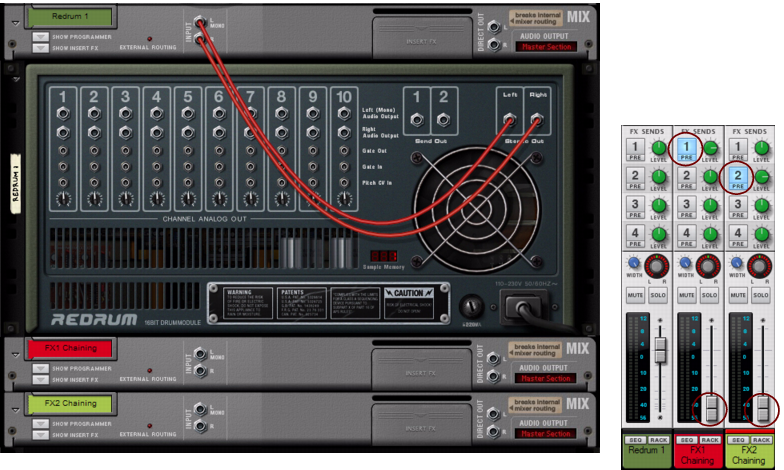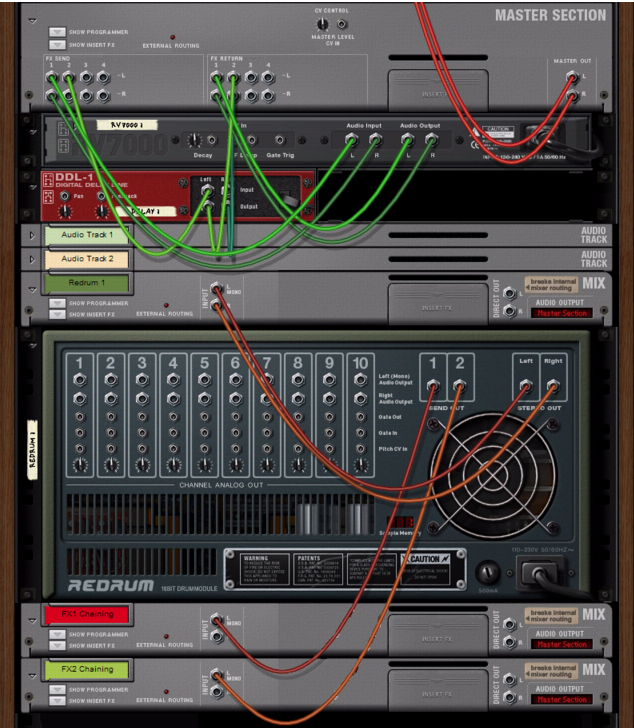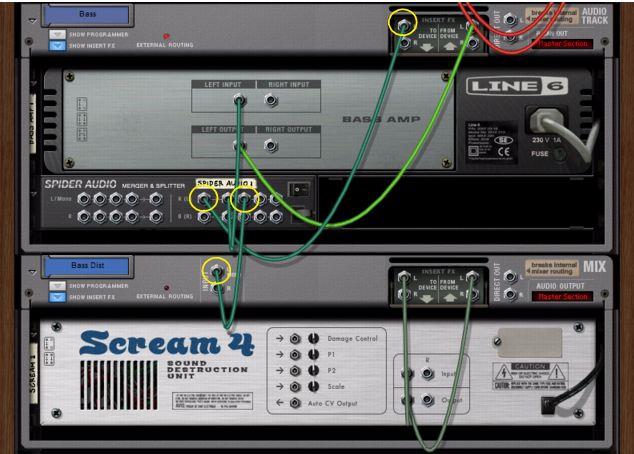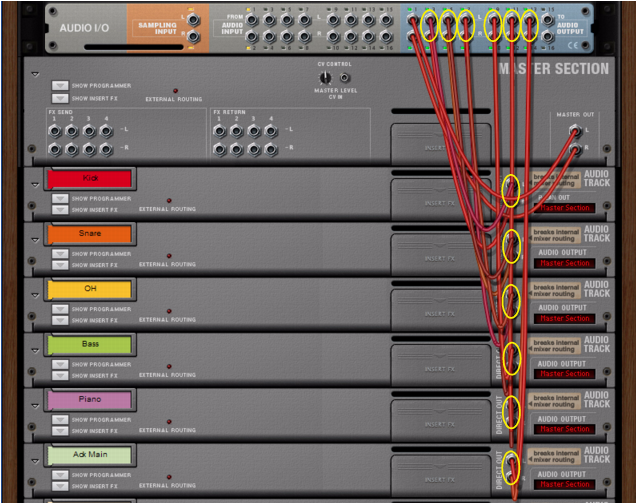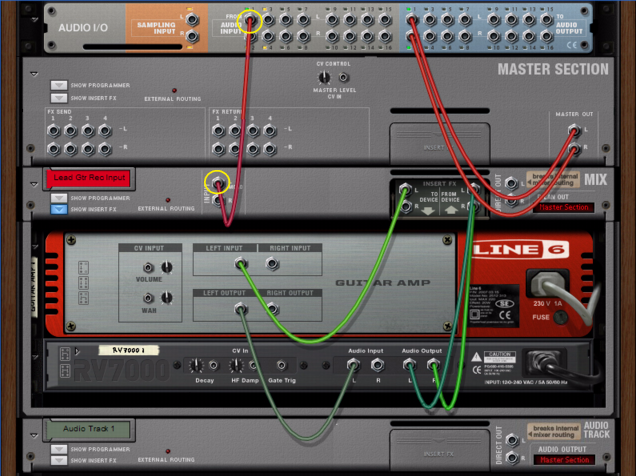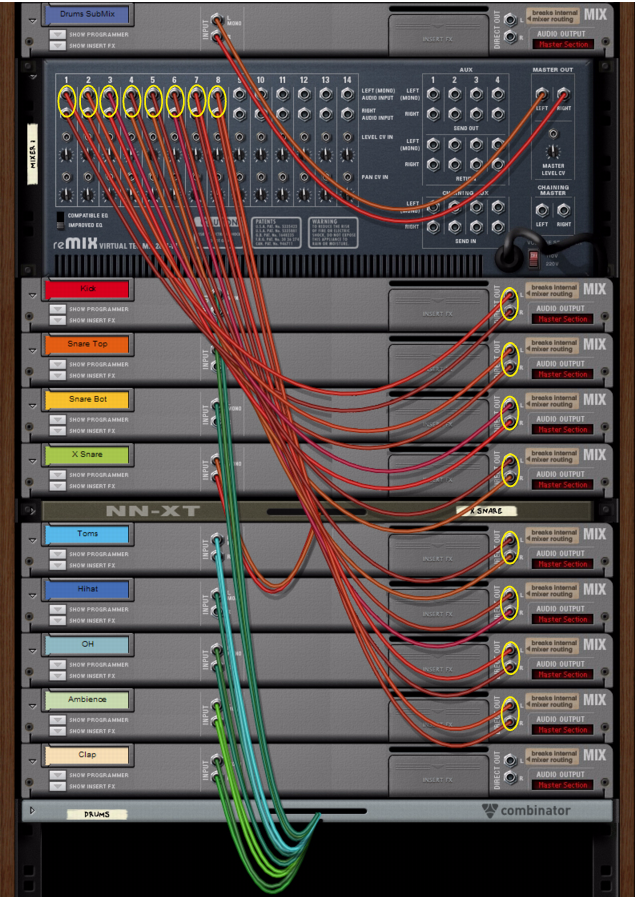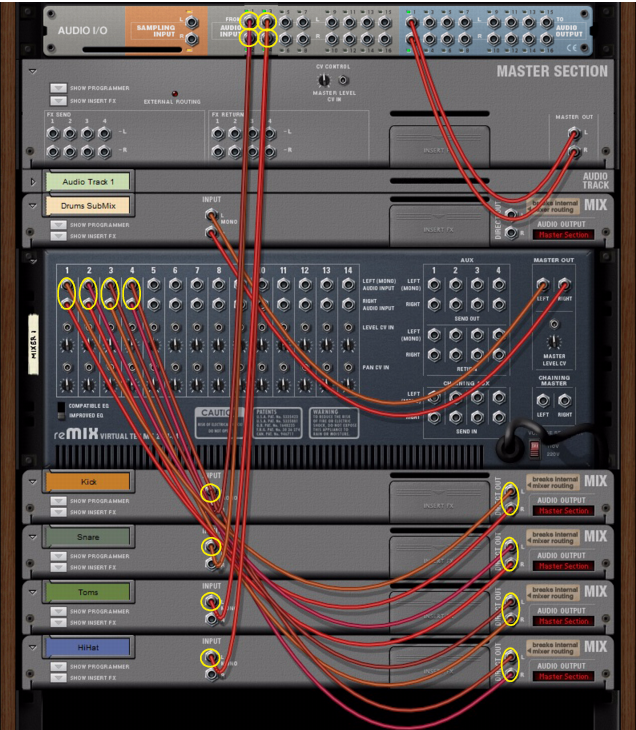The Redrum Drum Module and the Mixer 14:2 and 6:2 devices have separate Send FX connectors where you can add send effects individually for each device. The Redrum and Mixer devices also have separate Send FX level pots for each drum/mixer channel so that you could set the send effect levels individually for each drum/mixer channel in the device.
Let’s say you want to add a Redrum device and use two of the Main Mixer’s Send FX, but with individual settings for each of the Redrum device’s internal channels. In the example below, we’re going to chain the two Send Outs from the Redrum device to two send effects in the Main Mixer:
|
2.
|
In this example, we activate the Send FX 1 bus on the FX1 Chaining channel and the Send FX 2 bus on the FX 2 Chaining channel. The Send FX 1 has a reverb connected and the Send FX 2 has a delay connected. The Pre-fader buttons should be activated because we don’t want the mixer channel faders to affect the Send levels.
This way, the effect signals won’t be mixed with the rest of the Main Mixer channel signals in the mix bus, but are kept isolated in the Send FX busses. Now, our setup should look like this in the rack and in the Main Mixer:
|
4.
|
Connect the Send Out 1 and 2 of the Redrum device to the Left inputs of each of the “FX 1 Chaining” and “FX 2 Chaining” Mix Channel devices.
|
Now, you have individual send levels for each of the Redrum device’s internal channels - and are still able to use the Send FXs in the rest of the Main Mixer channels like before.
It’s possible to tap the signals from the Insert FX "To Devices" outputs of the Mix Channel/Audio Track device, without breaking the internal signal chain of the channel. This feature can be used if you want to apply “parallel” signal processing in an additional Mix Channel, for example.
The first example below shows an Audio Track with an electric bass. The Insert FX “To Device” signal of the Audio Track device is tapped to an additional Mix Channel which has a Scream 4 device as Insert FX. By adjusting the Level of the Bass Dist channel in the Main Mixer, you can gradually introduce the distortion effect, in parallel with the unprocessed bass sound of the audio track.
Tapping the signal from the Insert FX “To Device” of an Audio Track device to an additional Mix Channel device
for parallel signal processing.
for parallel signal processing.
If you are already using an Insert FX in the Audio track device, you can still tap the signal to another Mix Channel device for parallel signal processing by using a Spider Audio Merger and Splitter device as shown in the picture below:
Tapping the signal from the Insert FX chain of an Audio Track device to an additional Mix Channel device,
via a Spider Audio Merger and Splitter device.
via a Spider Audio Merger and Splitter device.
By adjusting the Level of the Bass Dist channel in the Main Mixer, you can gradually introduce the distortion effect, in parallel with the internally processed bass sound of the audio track. This way, you now have two parallel Insert FX signal chains for the audio track, where the tapped signal is adjustable.
The Mix Channel and Audio Track devices feature Direct Out connectors. By patching cables into these outputs, you break the internal signal chain from the device to the Master Section, and can route the channel output signals directly to the Reason Essentials Hardware Interface’s outputs. This is a very nice feature if you want to use outboard mixing or summing - or if you’re using ReWire (see “ReWire”) to route individual channel signals to another application.
You could also patch cables from the Direct Outs to a Mixer device to create a sub-mixer, for example (see “Creating a sub-mixer”).
The example below shows how to route the Direct Outs of a number of Audio Track devices to separate outputs of the Reason Essentials Hardware Interface:
When you record on an audio track, the input signal is routed “dry” to the audio track. Then, when you play back the recorded audio, the signal goes via the channel strip, with all its settings and any Insert FX etc. However, there might be situations where you want to record a processed signal to the audio track. For example, if you record an electric guitar, you might want to record it with distortion effects or similar.
The example below shows a typical setup where a separate Mix Channel device is used for processing the input signal before it’s routed to the audio track for recording:
This manual patching from the Hardware Interface is made to route the input signal directly to the Mix Channel device, where we have our effects.
|
6.
|
Finally, select the Mix Channel device as Input on the Audio Track in the sequencer (or in the Audio Input selector on the Audio Track device in the rack).
|
Now, you can begin recording on the Audio Track according to the standard recording procedures described in “General recording procedure”. The signal will be processed by the Insert FX of the Mix Channel device before being recorded on the track.
With this setup, you will always hear the sound of the input processed through the Amp device - just as if you had a real hardware amp turned on and mic'd in the studio. If you don't want the "Lead Gtr Rec Input" Mix channel to be heard, just mute it in the Main Mixer.
By using the Direct Outs of the Audio Track and Mix Channel devices and routing the signals to a Mixer device you can create a sub-mixer. A sub-mixer can be very useful for pre-mixing multi-mic’ed drums, or a horn section, for example.
The example below shows a number of Mix Channel devices to which various drum sounds have been routed from separate devices within a Combinator device. Each of the Mix Channel devices’ Direct Outs have then been manually routed to a Mixer 14:2 device, which is used as a sub-mixer in this setup. The sub-mixer is routed to a Mix Channel device, which is routed to the Main Mixer:
You can also use a sub-mixer configuration for routing several external input signals (from separate microphones, for example) for recording on an audio track.
The example below shows a sub-mixer configuration similar to the previous example, but with four separate microphones connected to one input each on the audio interface and then routed from the Reason Essentials Hardware Interface to Inputs on four Mix Channel devices. The Mix Channel devices’ Direct Outs are then routed to a Mixer 14:2 device, just as in the previous example:
|
|
To record the mixed signals from the “Drums Submix” Mix Channel on Audio Track 1, click the Rec Source button on the “Drums Submix” Mix Channel device, and then select “Drums Submix” as Input source on the “Audio Track 1” in the sequencer Track List. See “Recording audio from Mix Channel outputs” for more details.
|
|
|
In the sub-mixer setups above, the Mix Channels could also house individual Insert FX. See “Creating an input channel for recording with effects” for tips on how to record with FX.
|
